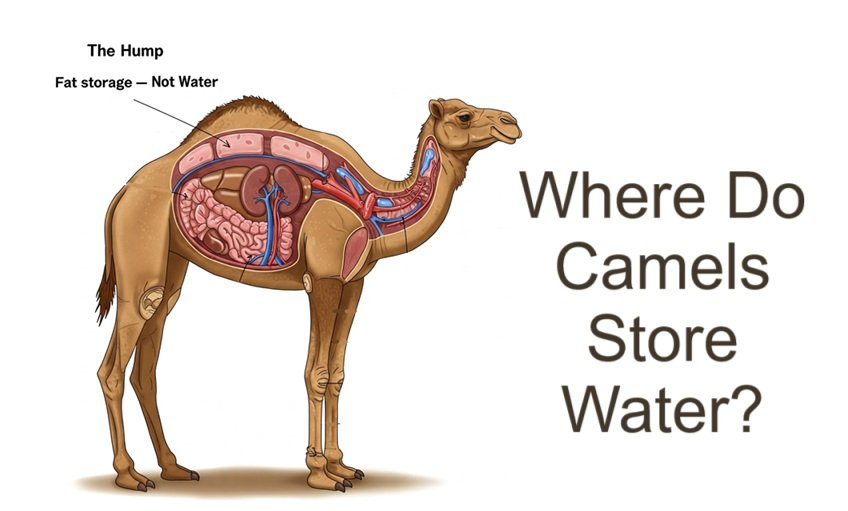
Camels are often dubbed the “ships of the desert” due to their incredible ability to survive in some of the harshest, driest environments on Earth. Their remarkable endurance, particularly when it comes to surviving without water for extended periods, has made them iconic symbols of resilience. The common misconception is that camels store water in their humps, but the truth is far more fascinating and complex. In this article, we will delve into how camels manage to survive in arid climates and where they truly store water.
1. Understanding Camel Physiology
Before we explore the specifics of water storage, it’s essential to understand a bit about camel physiology and their adaptations to the desert environment.
A. The Hump – A Reservoir of Fat, Not Water
The first and most widespread misconception about camels is that they store water in their humps. While it’s true that camels are capable of going without water for days or even weeks, the hump itself doesn’t store water. Instead, the hump is primarily a reservoir for fat. This fat acts as a vital energy source. In harsh desert conditions, where food is scarce, the camel can metabolize the fat stored in its hump to sustain itself.
However, the fat in the hump also plays a secondary role in water conservation. When camels metabolize this fat, the process produces water as a byproduct in a phenomenon known as metabolic water. This water helps the camel stay hydrated for longer periods, but it’s not the main source of hydration.
B. Water Conservation – A Key to Survival
Camels are desert-adapted creatures, and their ability to survive in hot and dry climates is attributed to several extraordinary features of their physiology. Their bodies are highly efficient in conserving water, preventing excessive sweating, and maintaining hydration under extreme conditions.
2. How Camels Conserve Water
While camels do not store water in their humps, they have evolved several mechanisms to help them retain water and minimize water loss in hot, arid environments.
A. Efficient Kidney Function
One of the key ways camels conserve water is through their highly efficient kidneys. Camel kidneys are adept at concentrating urine and minimizing water loss. In fact, camels can produce urine that is more concentrated than seawater, which helps them conserve as much water as possible. This allows them to drink large quantities of water in a short period and then go for long stretches without needing to drink again.
B. Nasal Adaptations
Camels also have specialized nasal passages that help prevent water loss. As air passes through their nostrils, it is humidified by moisture from their body. This reduces the amount of water lost through evaporation when they exhale. The moisture is then reabsorbed into their bodies rather than being lost to the atmosphere.
C. Sweating and Heat Tolerance
Camels are capable of withstanding temperature fluctuations that would be fatal to many other animals. Unlike humans, who begin to sweat when the temperature rises, camels have the ability to tolerate large shifts in body temperature. Their body temperature can fluctuate by several degrees throughout the day without causing harm. By allowing their body temperature to rise during the hottest part of the day, they reduce the need for cooling mechanisms like sweating. This process conserves water and prevents dehydration.
3. The Real Source of Water – Drinking and Absorption
While camels can go without water for an extended period, they still require water to survive. When they do drink, camels are capable of consuming massive quantities of water in a short period. A camel can drink up to 40 gallons (approximately 150 liters) of water in one go, often within 15 minutes. This ability to drink large amounts of water quickly helps them replenish their hydration reserves after a long period of deprivation.
A. Drinking Behavior
In the wild, camels rely on sporadic sources of water, such as oases or wells, during their journeys. When they find water, they drink heavily, absorbing as much as they can to compensate for the dehydration that has built up in their bodies. This ability to drink large amounts of water in one sitting is crucial for their survival, as it allows them to rehydrate quickly and efficiently.
B. Absorption and Retention
Once the camel drinks water, their bodies are designed to absorb and retain it for as long as possible. The camel’s digestive system is equipped to handle large amounts of water, and its stomach can expand to accommodate the influx. The water is absorbed through the gastrointestinal tract and is then transported throughout the body to hydrate cells and tissues.
4. Metabolic Water – The Role of Fat in Hydration
As mentioned earlier, the fat stored in a camel’s hump is metabolized when the animal needs energy, particularly when food is scarce. Interestingly, the breakdown of fat also produces metabolic water as a byproduct. This process provides an additional source of water for the camel when external water sources are not available.
Metabolic water is particularly important during long periods of water scarcity, such as when a camel is crossing a desert or is in an environment where water is rare. While metabolic water alone cannot fully replace the need for drinking water, it plays a vital role in helping the camel survive in harsh conditions.
5. How Camels Adapt to Extreme Heat
Another fascinating aspect of camels’ ability to survive in arid environments is their unique adaptation to heat. The desert heat can be extreme, with temperatures often exceeding 100°F (38°C), but camels have evolved to tolerate and even thrive in such conditions.
A. Insulating Fur
Camels have thick, woolly fur that helps insulate them from the intense heat during the day. While it may seem counterintuitive, the fur actually protects the camel from the sun’s rays, keeping their body temperature from rising too quickly. At night, when the temperature drops drastically, the fur helps keep the camel warm.
B. Ability to Withstand Dehydration
A camel’s body is capable of withstanding a significant loss of water without negative effects. They can lose up to 25% of their body weight due to sweating and still continue to function. Humans would experience severe dehydration and potentially death if they lost this amount of body weight in water. This remarkable ability allows camels to survive in environments where other animals would perish.
6. The Role of Camels in Human History and Culture
Throughout history, camels have been vital to human survival in desert regions. They have been used as pack animals for centuries, helping people transport goods across vast, arid landscapes. In many parts of the world, camels are still used for transportation, agriculture, and even racing. Their ability to survive without constant access to water has made them indispensable to the people living in desert regions.
In many cultures, camels have become symbols of endurance, strength, and resilience. They have played an important role in the development of trade routes, such as the famous Silk Road, which passed through some of the most arid regions in the world.
7. Conclusion
So, where do camels store water? Contrary to popular belief, camels do not store water in their humps. Instead, they have evolved several fascinating adaptations that help them survive in extremely dry environments. The hump serves as a storage of fat, which is metabolized to provide energy and even produce metabolic water. Camels conserve water through efficient kidney function, specialized nostrils, and the ability to withstand extreme temperature fluctuations. While they can go for extended periods without water, when they do drink, they are able to rehydrate rapidly, absorbing large amounts of water in a short time.
The camel’s ability to survive in the desert is a testament to nature’s ingenuity. Through a combination of anatomical, physiological, and behavioral adaptations, camels have become one of the most resilient creatures on Earth, capable of thriving where few others could survive. Their survival strategies—whether through water retention, fat metabolism, or heat tolerance—make them one of the most remarkable animals in the animal kingdom.
Explore Quizzes:
- Which country has first crowdfunded film?
- Zero-Watt Bulb: Kitni Bijli Khata Hai?
- Are Mushrooms Plants or Animals?
- Can the Human Body Glow in the Dark? The Science of Bioluminescence
- Where Is the World’s Largest Desert? know the Earth’s Vastest Landscapes
- Does It Snow in South India? A Look at Lambasingi
- What is the Weight of a Cloud? Understanding the Science Behind Clouds





